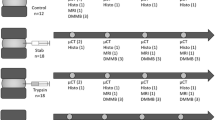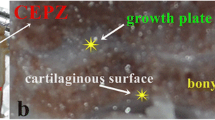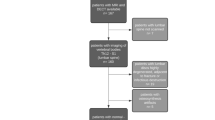Abstract
Quantitative magnetic resonance imaging (MRI) provides useful information about intervertebral disc (IVD) biomechanical properties, especially those in relation to the fluid phase. These properties may improve IVD finite element (FE) models using data closer to physiological reality. The aim of this study is to investigate IVD degeneration-related properties using a coupling between MRI and FE modeling. To this end, proton density (\(\rho _H\))-weighted MRI sequences of a porcine lumbar IVD were carried out to develop two biphasic swelling models with hyperelastic extracellular matrix behavior. The first model is isotropic, and the second one is anisotropic and takes into account the role of collagen fibers in the mechanical behavior of the IVD. MRI sequences permitted to determine the geometry and the real porosity mapping within the disc. The differentiation between disc components (nucleus pulposus, annulus fibrosus and cartilaginous end plates) was taken into account using spatial continuous distributions of the mechanical properties. The validation of the FE models was performed through two steps: the identification of the model’s mechanical properties using relaxation compressive test and the comparison between the MRI after load porosity distributions and those numerically obtained using the set of identified properties. The results confirmed that the two developed FE models were able to predict the mechanical response of uniaxial time-dependent compressive test and the redistribution of porosity after load. A slight difference between the measured and the numerical local bulges of the disc was found. This study suggests that from the coupling between MRI imaging in different state of load and finite element modeling we can deduce relevant information that can be used in the assessment of the early intervertebral disc degeneration changes.






Similar content being viewed by others
References
Adams MA, Dolan P, McNally DS (2009) The internal mechanical functioning of intervertebral discs and articular cartilage, and its relevance to matrix biology. Matrix Biol 28:384–389
Antoniou J, Demers CN, Beaudoin G, Goswami T, Mwale F, Aebi M, Alini M (2004) Apparent diffusion coefficient of intervertebral discs related to matrix composition and integrity. Magn Reson Imaging 22:963–972
Argoubi M, Shirazi-Adl A (1996) Poroelastic creep response analysis of a lumbar motion segment in compression. J Biomech 29:1331–1339
Baldit A, Ambard D, Cherblanc F, Royer P (2014) Experimental behavior of the transverse mechanical behavior of annulus fibrosus tissue. Biomech Model Mechanobiol 13(3):643–652
Baptista J, Fontes R, Liberti E (2015) Aging and degeneration of the intervertebral disc: review of basic science. Coluna/Columna 14(2):144–148
Barthelemy VMP, Van Rijsbergen MM, Wilson W, Huyghe JM, Van Rietbergen B, Ito K (2016) A computational spinal motion segment model incorporating a matrix composition-based model of the intervertebral disc. J Mech Behav Biomed Mater 54:194–204
Belytschko TB, Kulak RF, Schultz AB, Galante JO (1974) Finite element stress analysis of an intervertebral disc. J Biomech 7: 277–285
Ben-Abraham EI, Chen J, Felmlee JP, Rossman P, Manduca A, An KN, Ehman RL (2017) Feasibility of MR elastography of the intervertebral disc. Magn Reson Imaging 39:132–137
Boos N, Weissbach S, Rohrbach H, Weiler C, Spratt KF, Nerlich AG (2002) Classification of age-related changes in lumbar intervertebral discs. SPINE 27(3):2631–2644
Cassidy JJ, Hiltner A (1989) Hierarchical structure of the intervertebral disc. Connect Tissue Res 23(1):57–88
Castro APG, Wilson W, Huyghe JM, Ito K, Alves JL (2014) Intervertebral disc creep behavior assessment through an open source finite element solver. J Biomech 47:297–301
Chen CT, Malkus DS, Vanderby R Jr (1998) A fiber matrix model for interstitial fluid flow and permeability in ligaments and tendons. Biorheology 35(2):103–118
Cheung JTM, Zhang M, Chow DHK (2003) Biomechanical responses of the intervertebral joints to static and vibrational loading: a finite element study. Clin Biomech 18:790–799
Cortes DH, Elliot DM (2012) Extra-fibrillar matrix mechanics of annulus fibrosis in tension and compression. Biomech Model Mechanobiol 11(6):781–790
Cortes DH, Jacobs NT, DeLucca JF, Elliott DM (2014) Elastic, permeability and swelling properties of human intervertebral disc tissues: a benchmark for tissue engineering. J Biomech 47: 2088–2094
Cotten A, Demondion X (2000) Développement et vieillissement du disque intervertébral lombaire. Revue de rhumatisme 67(4):207–213 (French edition)
Drost MR, Willems P, Snijders H, Huyghe JM, Janssen JD, Huson A (1995) Confined compression of canine annulus fibrosus under chemical and mechanical loading. J Biomech Eng 117(4): 390–396
Frederico S, Herzog W (2008) On the permeability of fibre-reinforced porous materials. Int J Solids Struct 45:2160–2172
Galbusera F, Schmidt H, Noailly J, Malandrino A, Lacroix D, Wilke HJ, Shirazi-Adl A (2011) Comparison of four methods to simulate swelling in poroelastic finite element models of intervertebral discs. J Mech Behav Biomed Mater 4:1234–1241
Ghiss M, Giannesini B, Tropiano P, Tourki Z, Boiron O (2015) Quantitative MRI water content mapping of porcine intervertebral disc during uniaxial compression. Comput Methods Biomech Biomed Eng 19(10):1079–1088
Guerin HAL, Elliot DM (2006) Degeneration affects the fiber orientation of human annulus fibrosus under tensile load. J Biomech 39:410–1418
Hollingsworth NT, Wagner DR (2011) Modeling shear behavior of the annulus fibrosus. J Mech Behav Biomed Mater 4:1103–1114
Holm S, Ekström L, Kaigle Holm A, Hansson T (2007) Intradiscal pressure in the degenerated porcine intervertebral disc. Vet Comp Orthop Trautomatol 1:29–33
Holmes MH, Mow VC (1986) The non linear characteristics of soft gels and hydrated connective tissues in ultrafiltration. J Biomech 23(11):1145–1156
Holmes MH (1990) Finite deformation of soft tissue:analysis of a mixture model in uni-axial compression. J Biomech Eng 108:372–381
Holzapfel G, Sommer G, Gasser CT, Regitnig P (2005) Determination of layer-specific mechanical properties of human coronary arteries with nonatherosclerotic intimal thickening and related constitutive modeling. Am J Physiol Heart Circ Physiol 289:H2048–H2058
Iman RB, Hu S, DeLosSantos L, Claude J, Peacock J, Majumdar S, Kurhanewicz J (2010) HR-MAS spectroscopy of human intervertebral disc tissue demonstrates the lactate/N-Acetyl ratio as a potential marker for painful degenerative disc disease. Proc Int Soc Magn Reson Med 18:812
Jackson AR, Huang CY, Brown M, Gu WY (2011) 3D finite element analysis of nutrient distributions and cell viability in the intervertebral disc: effect of deformation and degeneration. J Biomech Eng 133:091006
Jacobs NT, Cortes DH, Peloquin JM, Vresilovic EJ, Elliott DM (2014) Validation and application of an intervertebral disc finite element model utilizing independently constructed tissue-level constitutive formulations that are nonlinear, anisotropic, and time-dependent. J Biomech 47:2540–2546
Lai WM, Mow VC (1980) Drag-induced compression of articular cartilage during a permeation experiment. Biorheology 17:111–123
Mengoni M, Luxmoore BJ, Wijayathunga VN, Jones AC, Broom ND, Wilcox RK (2015) Derivation of inter-lamellar behaviour of the intervertebral disc annulus. J Mech Behav Biomed Mater 48:164–172
Modic MT, Masaryk TJ, Ross JS, Carter JR (1988) Imaging of degenerative disk disease. Radiology 168(1):177–186
Mok GSP, Zhang D, Chen SZ, Yuan J, Griffith JF, Wang YXJ (2016) Comparison of three approaches for defining nucleus pulposus and annulus fibrosus on sagittal magnetic resonance images of the lumbar spine. J Orthop Transl 6:34–41
Mow VC, Kuei SC, Lai WM, Armstrong CG (1980) Biphasic creep and stress relaxation of articular cartilage in copression: theory and experiment. J Biomech Eng 102:73–84
Nachemson A, Morris JM (1964) In vivo measurements of intradiscal pressure. J Bone Joint Surg [Am] 46:1077–1092
Nazari J, Pope MH, Graveling RA (2015) Feasibility of magnetic resonance imaging (MRI) in obtaining nucleus pulposus (NP) water content with changing postures. Magn Reson Imaging 33:459–464
Périé D, Korda D, Iatridis JC (2005) Confined compression experiments on bovine nucleus pulposus and annulus fibrosus: sensitivity of the experiment in the determination of compressive modulus and hydraulic permeability. J Biomech 38:2164–2171
Périé D, Mclean JJ, Owen JP, Iatridis JC (2006) Correlating material properties with tissue composition in enzymatically digested bovine annulus fibrosus and nucleus pulposus tissue. Ann Biomed Eng 34(5):769–777
Perry J, Haughton V, Anderson PA, Wu Y, Fine J, Mistretta C (2006) The value of T2 relaxation times to characterize lumbar intervertebral disks: preliminary results. Am J Neuroradiol 27:337–342
Reutlinger C, Bürki A, Brandejsky V, Ebert L, Büchler P (2014) Specimen specific parameter identification of ovine lumbar intervertebral discs: on the influence of fibre-matrix and fibre–fibre shear interactions. J Mech Behav Biomed Mater 30:279–289
Riches PE, Dhillon N, Lotz J, Woods AW, McNally DS (2002) The internal mechanics of the intervertebral disc under cyclic loading. J Biomech 35:1263–1271
Schmidt H, Reitmaier S (2013) Is the ovine intervertebral disc a small human one? A finite element model study. J Mech Behav Biomed Mater 17:229–241
Schroeder GD, Markova DZ, Koerner JD, Rihn JA, Hilibrand AS, Vaccaro AR, Anderson DG, Kepler CK (2017) Are Modic changes associated with intervertebral disc cytokine profiles? Spine J 17(1):129–134
Smith LJ, Fazzalari NL (2009) The elastic fibre network of the human lumbar anulus fibrosus: architecture, mechanical function and potential role in the progression of intervertebral disc degeneration. Eur Spine J 18:439–448
Squires A, Chan KC, Ho LC, Sigal IA, Jan N-J, Ho Tse ZT (2016) MAPS: a magic angle positionning system for enhanced imaging in high field small-bore MRI. J Med Robot Res 1:1–7
Whatley BR, Wen X (2012) Intervertebral disc (IVD): structure, degeneration, repair and regeneration. Mater Sci Eng C 32:61–77
Wilson W, Van Donkelaar CC, Huyghe JM (2005) A comparison between mechano-electrochemical and biphasic swelling theories for soft hydrated tissues. J Biomech Eng 17:158–165
Wright AC, Yoder JH, Vresilovic EJ, Dawn ME (2016) Theory of MRI contrast in the annulus firbrosus of the intervertebral disc. MAGMA 29(4):711–722
Xia Y, Moody JB, Alhadlaq H (2002) Orientational dependance of T2 relaxation in articular cartilage: a microscopic MRI study. Magn Reson Med 48:460–469
Yang B, O’Connell GD (2017) Effect of collagen fiber orientation on intervertebral disc torsion mechanics. Biomech Model Mechanobiol 16:2005–2015
Zheng G, Chu C, Belavý Daniel L, Ibragimov B, Korez R (2017) Evaluation and comparison of 3D intervertebral disc localization and segmentation methods for 3D T2 MR data: a grand challenge. Med Image Anal 35:327–344
Zou J, Yang H, Miyazaki M, Morishita Y, Wei F, McGovern S, Wang JC (2009) Dynamic bulging of intervertebral discs in the degenerative lumbar spine. SPINE 34(23):2545–2550
Acknowledgements
A part of this work has been carried out in the framework of the labex MEC (ANR-10-LABX-0092). The authors thank Pr. Patrick Tropiano (Orthopedic surgeon, APHM La Timone hospital, Marseille) and Gaetan Aüllo-Rasser (PHD, RLC systems and Aix-Marseille university) for their contribution in this work.
Author information
Authors and Affiliations
Corresponding author
Ethics declarations
Conflict of interest
The authors declare that they have no conflicts of interest.
Additional information
Publisher's Note
Springer Nature remains neutral with regard to jurisdictional claims in published maps and institutional affiliations.
Rights and permissions
About this article
Cite this article
Chetoui, M.A., Boiron, O., Ghiss, M. et al. Assessment of intervertebral disc degeneration-related properties using finite element models based on \(\uprho _H\)-weighted MRI data. Biomech Model Mechanobiol 18, 17–28 (2019). https://doi.org/10.1007/s10237-018-1064-1
Received:
Accepted:
Published:
Issue Date:
DOI: https://doi.org/10.1007/s10237-018-1064-1




